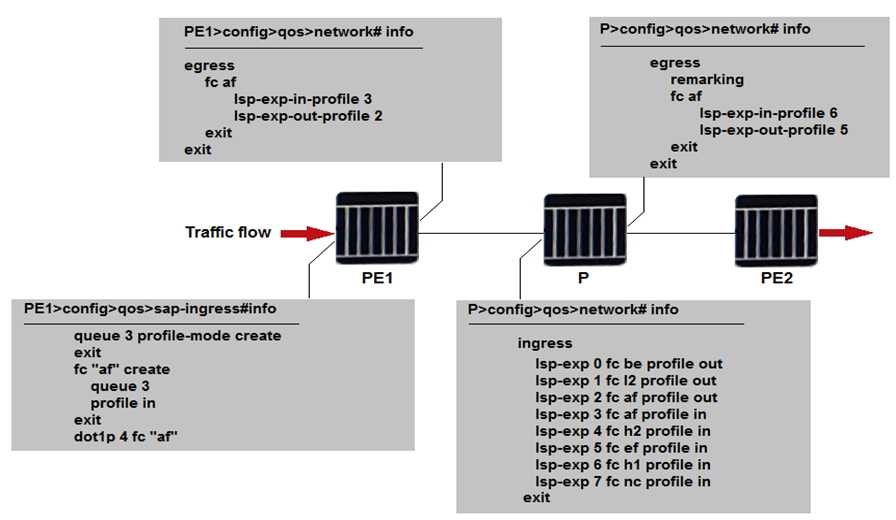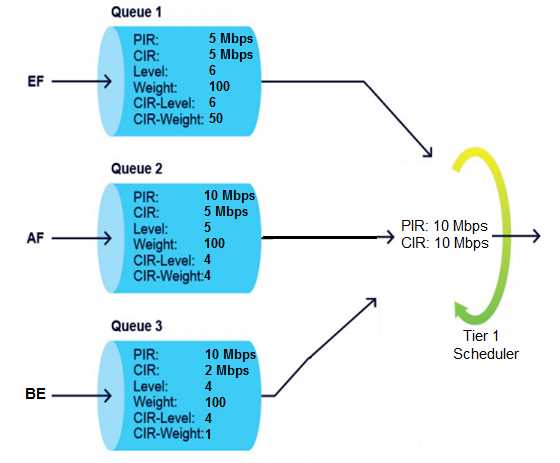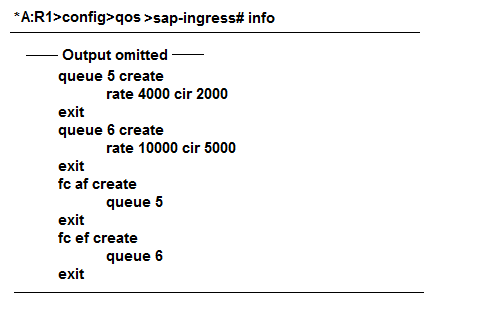nokia 4A0-107 Exam Questions
Questions for the 4A0-107 were updated on : Nov 21 ,2025
Page 1 out of 16. Viewing questions 1-15 out of 231
Question 1
Refer to the exhibit.
In the diagram shown above, applying policing and soft-policing on access ingress is typical for which
of the following types of traffic?
- A. Real-time
- B. Assured
- C. Best-effort
- D. Self-generated
Answer:
C
Question 2
Refer to the exhibit.
Traffic corresponding to a layer-3 VPN arrives at router PE1 marked with a dot1p value of 4. The SDP
carrying the traffic uses an MPLS transport tunnel. Given the policies applied on the routers in the
diagram, what is the EXP value of packets arriving at router PE2?
- A. 2
- B. 3
- C. 5
- D. 6
Answer:
D
Question 3
Which of the following fields in packets belonging to a Layer 3 service can be pre-marked on SAP-
ingress?
- A. Dot1p
- B. DEI
- C. EXP
- D. DSCP/PREC
Answer:
D
Question 4
Which of the following CANNOT be used as external marking bits?
- A. IP Precedence
- B. Dot1p
- C. Forwarding class
- D. EXP
Answer:
C
Question 5
Refer to the exhibit.
According to the configuration shown above, which of the following about the classification and
marking of self- generated BGP traffic is TRUE?
- A. It will be marked as DSCP BE and classified into forwarding class BE.
- B. It will be marked as DSCP NC1 and classified into forwarding class BE.
- C. It will be marked as DSCP NC1 and classified into forwarding class NC.
- D. It will be marked as DSCP NC1 and classified into forwarding class AF.
Answer:
D
Question 6
Which of the following self-generated traffic applications is considered “protocol” traffic, as opposed
to “management” traffic?
- A. BGP
- B. Telnet
- C. ICMP
- D. SNMP
Answer:
A
Question 7
Which of the following about the process of queuing self-generated traffic in the Nokia 7750 SR is
TRUE?
- A. Ingress traffic is stored in IOM queues and egress traffic is stored in CPM queues.
- B. Ingress traffic is stored in CPM queues and egress traffic is stored in IOM queues.
- C. It is always stored in CPM queues.
- D. It is always stored in IOM queues.
Answer:
B
Question 8
Which priority-mode queue parameter may influence both the profile marking, and scheduling
priority of a queue?
- A. PIR
- B. CIR
- C. MBS
- D. burst-limit
Answer:
B
Question 9
Refer to the exhibit.
Given the scheduler-policy parameters shown, and assuming the offered rate of each queue is 10
Mbps, what are the operational PIR and CIR for queue 3?
- A. PIR = 4 Mbps, CIR = 1 Mbps
- B. PIR = 1 Mbps, CIR = 1 Mbps
- C. PIR = 10 Mbps, CIR = 1 Mbps
- D. PIR = 5 Mbps, CIR = 1.25 Mbps
- E. PIR = 1.25 Mbps, CIR = 1.25 Mbps
Answer:
C
Question 10
Which of the following statements about the default scheduler in the Nokia 7750 SR is TRUE?
- A. A queue will be serviced as expedited if all of the forwarding classes mapped to it are expedited, regardless of its configured type.
- B. A queue will be serviced as best-effort if all of the forwarding classes mapped to it are best-effort, regardless of its configured type.
- C. A queue will be serviced as expedited if at least one of the forwarding classes mapped to it is expedited, regardless of its configured type.
- D. A queue will be serviced as expedited if its type is configured as expedited, regardless of the forwarding classes mapped to it.
Answer:
A
Question 11
What type of unwanted packet drops can the proper configuration of a queue’s burst-limit parameter
prevent?
- A. Packet drops in the local queue resulting from traffic congestion.
- B. Packet drops on the downstream nodes resulting from traffic congestion.
- C. Packet drops in the local queue resulting from traffic bursts.
- D. Packet drops on the downstream nodes resulting from traffic bursts.
Answer:
C
Question 12
Which of the following statements about port schedulers is TRUE?
- A. A port scheduler can only be implemented on a network egress port when queue-groups are configured for that port.
- B. A port scheduler can be implemented on an access ingress port.
- C. A port scheduler can be implemented without HQoS on an access egress port.
- D. A port scheduler can be implemented on a network ingress port.
Answer:
C
Question 13
Assume all transmitted frames on a SONET port are 1500 bytes and that the average frame overhead
has been configured as 10%. If the total bandwidth of all queues, excluding overhead, needs to be
guaranteed at 55 Mbps, how much bandwidth should be configured for the egress port scheduler
applied on that port?
- A. 55 Mbps / 1.1 = 50 Mbps
- B. 55 Mbps
- C. 55 Mbps + 55 Mbps * 0.1 / 1.1 = 60 Mbps
- D. 55 Mbps * 1.1 = 60.5 Mbps
Answer:
D
Question 14
When using an egress port scheduler, which scheduling loop priority are orphaned queues serviced
on?
- A. 1st
- B. 8th
- C. 9th
- D. 17th
Answer:
A
Question 15
Refer to the exhibit.
Based on the image shown above, and assuming that the default scheduler of the Nokia 7750 SR is
on an IOM2 card, in which order will packets be scheduled?
- A. Queue 6 within-CIR packets, then queue 5 within-CIR packets, then queue 5 and queue 6 above- CIR packets in round-robin.
- B. Queue 6 within-CIR packets, then queue 5 within-CIR packets, then queue 5 and queue 6 above- CIR packets in biased round-robin.
- C. Queue 6 within-CIR packets, then queue 5 within-CIR packets, then queue 6 above-CIR packets, and finally queue 5 above-CIR packets.
- D. Queue 6 and queue 5 within-CIR packets in biased round-robin, then queue 5 and queue 6 above- CIR packets in round-robin.
Answer:
B